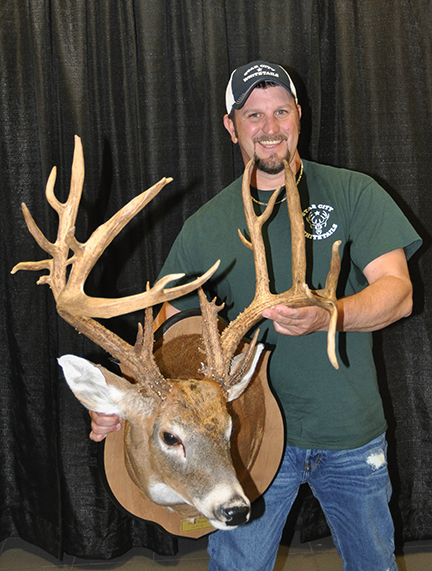
As a fuzz-cheeked sports reporter many years ago in Martinsville, I asked the sports editor if I might write about outdoors events in Bulletin Country.
Anxious to keep me around because of a paltry salary, he agreed (and I needed the writing experience). That fall and winter I was stunned by the wall-hanger bucks local deer hunters brought to the office on Broad Street.
Because Commonwealth whitetails weren’t publicized and almost none lived where I was raised in central North Carolina (the Dixie Deer Classic wouldn’t appear for eight years), southern Virginia’s Blue Ridge bucks looked like they’d stepped out of Midwest hunting magazines.
The lack of trophy-deer publicity may have held back its reputation, but it’s been rising each year, currently rated 20th to 27th by national hunting magazines.
With 1 million deer and just 75,000 hunters, Virginia today leads the Southeast in impressive whitetails.
The Virginia Department of Game and Inland Fisheries helps by wisely managing the state’s herd for quality rather than quantity, with two distinct regulations areas (east and west) and different bag limits at each region.
Challenges remain, from deer diseases (chronic wasting disease has crept into a few northwest counties and EHD outbreaks that periodically occur) to decreasing habitat and coyote predation. But three monster bucks from 2016 show the overall state of deer affairs is healthy in the Old Dominion.
BEAUTY OF A BEAST
Brent Boney, 42, works for Greensville County Water and Sewer near Emporia and belongs to the Round Hill Hunting Club of Skipper.
“We’ve got 15 members and 20 Walker hounds,” he said. “We lease 600 acres where we still- and dog-hunt. We take more deer while dog-hunting, but still-hunters kill bigger bucks.”
He should have added “usually” because that didn’t happen Nov. 16, 2016, when Boney dropped a 210 6/8-inch 25-pointer, the top-scoring southern rack at the 2017 Dixie Deer Classic and a Boone & Crockett qualifier.
“We use dogs exclusively during the two big winter holidays, Thanksgiving and Christmas,” Boney said.
The club has an agreement with an adjoining landowner, who only allows still-hunting.
“The deer know they’d be safe if they can make it to his land,” Boney said. “The ones we jumped always went to a certain section near the back of our lease (to enter the de facto sanctuary).”
Club members draw for stand sites. In 2015 Boney picked a zone near the sanctuary because he’d seen a handful of small trees destroyed by a big buck’s rubs. During November 2016 the hounds jumped a rocking-chair rack deer, and it ran within 40 yards of him, but Boney couldn’t get a clear shot in the thick 6- to 7-year-old cutover. Unluckily, a holly bush absorbed most of the 00 buckshot.
“I told the other club members what happened, and they laughed,” he said. “I don’t know if they believed me. No one had seen a deer like that.”
In February 2016, Boney returned to the area and brought a machete. He used it to clear several shooting lanes off a main trail he walked to reach his spot.
“I was gonna be ready if I got a chance at him again,” he said.
Opening day of 2016 gun season Boney once again pulled a number that allowed him to hunt the same region. His 18-year-old daughter, McKaley Boney, was one of several designated dog handlers.
“I sat and listened to dogs for two hours and was about to give up when she called me (with a cell phone),” he said. “She told me to sit tight because she’d just caught four hounds crossing a road onto someone else’s property. She planned to drive near me and release the dogs.”
A minute or two later, Boney heard the hounds open up on a deer that seemed headed straight for him.
“He was about 100 yards in front of the dogs when he came through one of the shooting lanes,” the hunter said.
Boney put his Remington 870 Magnum Wingmaster shotgun, loaded with 00 buckshot, to his shoulder and fired when the buck trotted into a shooting lane. The deer stumbled, fell, and didn’t get up.
“When I walked to him and saw his antlers, I said, ‘Oh, my Lord,'” Boney said. “I had never seen anything like this deer.”
Its 5×5 mainframe rack had 25 scoreable tines and points, including nine abnormals on the right main beam and six on the left beam. Officially scored after 60 days, it had a right main beam of 26 6/8 inches and the left taped 26 3/8 inches. Brow tines were 5 3/8 and 7 0/8 while G2s were 11 6/8 and 11 7/8. G3s were 10 4/8 and 11 7/8 inches with G4s at 2 5/8 and 6 4/8 inches. The circumference numbers ranged from 5 0/8 (H1) to 3 1/8 (H4) inches. The inside spread totaled 18 1/8 inches while the outside spread was 21 4/8 inches.
The Virginia record non-typical buck, a 31-pointer killed by muzzle-loader hunter Jim Smith of Chilhowie in Warren County during 1992, taped 257 4/8 inches.
BATTERY-POWERED BUCK
Rodney Wingfield barely contained his excitement Oct. 1, 2016, the first day of archery season in Virginia.
“A trail camera I had put up near a Franklin County field got some pictures of a big buck before the season opened,” said the 42-year-old Martinsville resident, who put a crossbow bolt through a B&C qualifier (177 7/8 net typical inches) that day.
Henry County, with Martinsville at the center, borders Franklin County on its northern boundary.
Wingfield, 42, and a self-employed IT technician for a Greensboro (N.C.) company, had secured a Leaner Deluxe two-person 18-foot ladder tree stand against an oak beside a 10-acre field.
“It’s a big grassy field out in the middle of nowhere and is too big to hunt with a regular bow, which is how my dad, Raymond, and my brother, Elan, hunt,” he said. “But the field, ringed by some hardwoods and pines, is considered a high-traffic (deer) area.”
Wingfield admitted he’s not a hard-core hunter, but he was confident in his ability to shoot a Barnett Quad 400 crossbow he’d purchased from a friend seven or eight years earlier.
“I can hit a (dinner) plate (target) at 50 yards pretty regular,” he said. “The crossbow shoots flat, out to 50 yards. It has a red-dot scope on top. But I didn’t get up early on opening day to hunt in the morning and that afternoon I wore blue jeans, a camouflage t-shirt and didn’t use an scent-blocker or face paint.”
Wingfield, who had two crossbow whitetails to his credit, had hunted from the tree stand in the past and knew where deer likely would enter the field.
“They always seemed to come from off my right shoulder, so that’s where I was watching,” he said.
But he discovered when he picked up the crossbow that its battery-powered scope had been left in the “on” position and might lack power.
“I wasn’t too worried because I got into the stand about 4:45 p.m., and there should be plenty of daylight,” Wingfield said. “But if deer didn’t move until available light got low, I turned the scope off and hoped I could put it on high power and maybe make the dot glow when I needed it. Otherwise I’d guess about an aim point.”
Farms surrounding the Wingfields’ land had been leased and planted in soybeans, so the field was a crossing area for whitetails.
He’d already decided he wouldn’t take a chancy shot because he’d learned during preseason practice that 50 yards was his accuracy limit.
After a few minutes passed, a small six-pointer walked into the field and began sniffing the ground about 40 yards from Wingfield’s stand.
“He came from behind me,” he said. “No deer ever had come from that direction. Then I heard something else back there and figured it was a coyote.”
But the sound wasn’t a coyote. Instead the buck with 189 4/8 gross antler inches appeared 20 yards to Wingfield’s right. He put the faint red dot on the deer’s left shoulder and squeezed the crossbow’s trigger.
The deer never knew what hit it as the broadhead, pushed at 345 feet per second, sizzled through both lungs.
“He took five steps and fell over,” said Wingfield, who waited until dark before climbing down from his stand.
“I got my truck and drove to him, but I couldn’t lift him into the bed,” he said. “I had to drive home and get my brother and his girlfriend. They helped load the deer.”
The buck only weighed 120 pounds, but the experience — and seeing the massive headgear — drained Wingfield.
“My dad said he’d never seen a buck like this one in 40 years,” the hunter said. “All my brother could do was shake his head.”
Virginia’s non-typical deer archery record is shared by Clifton Forge’s John Feazell, who downed a 22-point Botetourt County trophy in 2009 that totaled 221 2/8 Pope&Young inches while Jimmy “Bo” Sturgill of Pound shot a 27-point, 221 2/8 buck in Wise County during November 2011.
BROOMSTRAW BOOMER
Jason Hazelwood, who drives a cement truck for Felton Brothers Transit Mixes of South Hill, put his fingerprints in Old Dominion hunting records Nov. 6, 2016.
That’s when his .50-caliber CVA in-line muzzleloader rifle dropped a Mecklenburg County buck with a nearly perfect rack that totaled 165 net Boone & Crockett inches, 5 inches shy of qualifying as an all-time B&C buck. It earned entry into the organization’s Awards category and its gross score totaled 172 6/8 inches.
It was likely Virginia’s top typical muzzleloader buck of 2016.
“We were hunting a farm with 270 acres that had a 3-acre broomstraw field,” he said.
“It was a spur-of-the-moment thing (to hunt for the field). It had a stand that had been there a couple of years before, a 12-foot-tall buddy stand.”
Although Hazelwood hadn’t seen the big whitetail and had no trail-cam photos, he was confident through second-hand information a large buck lived in the area.
“Some other people had photographs of him,” he said. “I knew there was a possibility he was there.”
The 37-year-old had hunted unsuccessfully during archery season, but those excursions gave him confidence he wasn’t wasting his time.
“I didn’t see him during bow season, but I did find scrapes along the edge of the field and some nice (tree) rubs.”
Virginia allowed Sunday hunting in 2014 when Governor Terry McAuliffe signed a bill that gave property-owners the right to hunt big game, including deer, on their own land. It also gave visitors the right to hunt with a landowner’s permission.
Certainly that ruling helped Hazelwood bag his trophy Oct. 1, 2016, which was a Sunday.
 “I got into the stand about 4:15 p.m.,” he said. “It was on the edge of the broomstraw field.”
“I got into the stand about 4:15 p.m.,” he said. “It was on the edge of the broomstraw field.”
After he waited a few minutes, three does came into view.
“A little while later, another doe ran into the field, chased by the buck,” Hazelwood said. “The rut was on, and he had his neck stretched out and his nose down. Then he must have scented one of the other does and started to chase her.”
When the hunter saw the buck’s rack, he admitted he caught a case of buck fever.
It helped to settle his muzzle-loader’s barrel, holding 100 grains of black powder and seated underneath a 280-grain Sabot bullet, on a rail around the stand.
“I watched him chase that doe for 3 minutes and felt like he was going to run her out of the field, so I took the shot at about 75 yards,” he said. “I was looking through a 3x9x50 scope, aimed at his front shoulder but hit him a little farther back.”
When the buck left the field, the hunter burned the spot in his memory. Hazelwood couldn’t find any blood sign but walked to his last sighting of the wall-hanger and found the beautiful deer piled up a few steps into the woods.
The rack’s main beams were 24 3/8 and 25 3/8 inches, with G2s of 10 3/8 and 10 6/8 and G3s of 9 4/8 and 10 4/8 inches. Only one 2-inch abnormal point, 3 inches of total asymmetrical tine length and 5/8 inch of circumference difference marred its 5×5 main frame antlers.

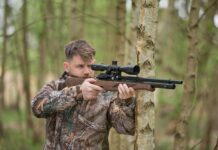






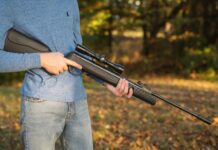






























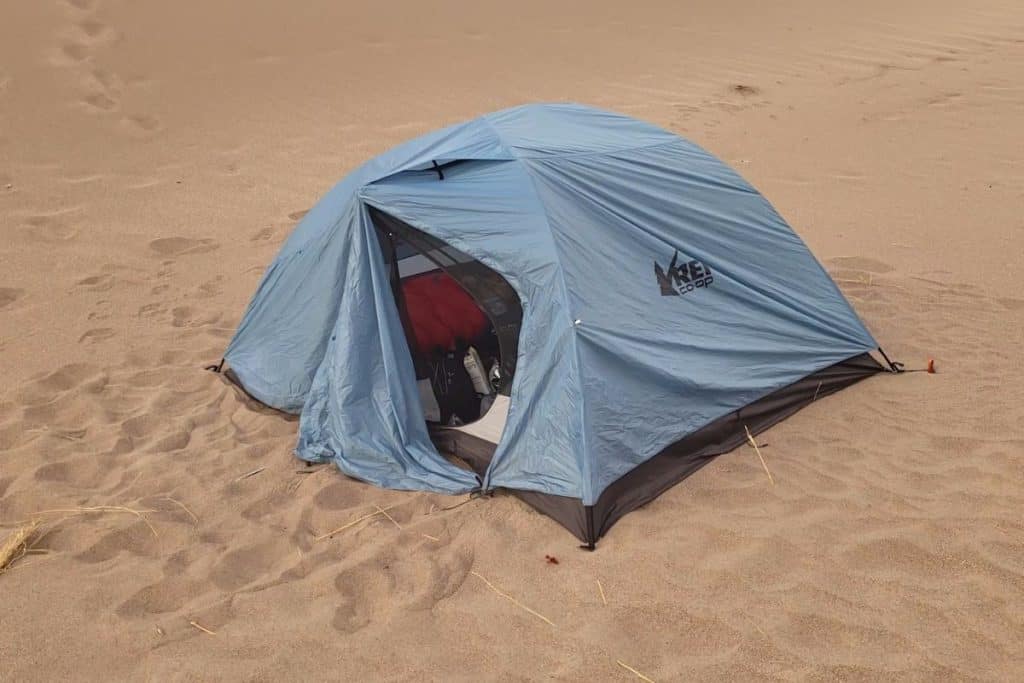

























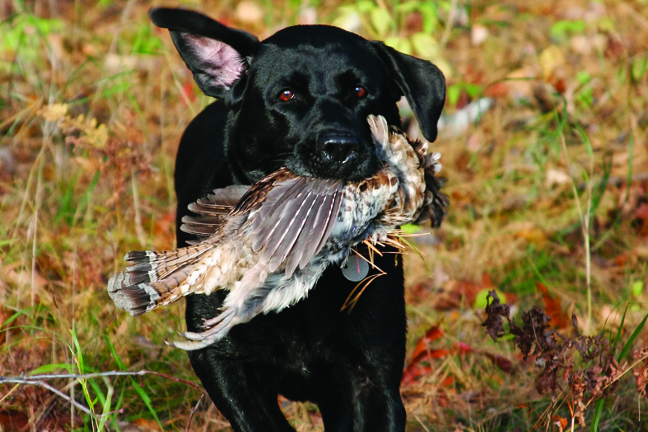
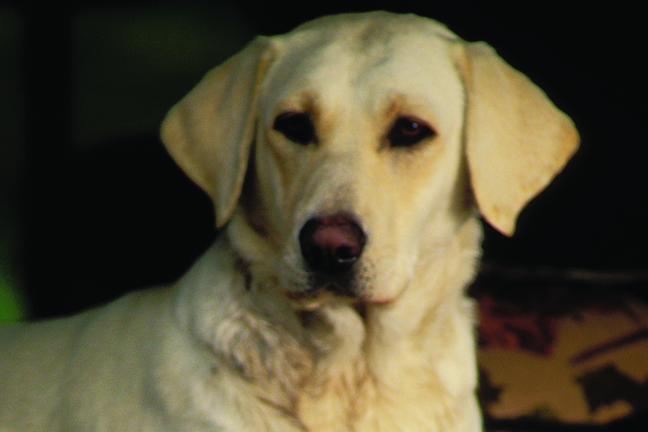


![Air gun 101: The differences between .177 & .22 – Which jobs they do best ? [Infographic]](https://airgunmaniac.b-cdn.net/wp-content/uploads/2024/11/1773-150x150.jpeg)


